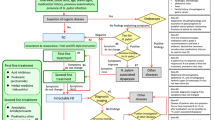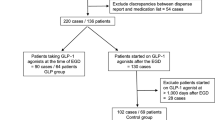Abstract
Hiatus hernia (HH) is a prevalent endoscopic finding in clinical practice, frequently co-occurring with esophageal disorders, yet the prevalence and degree of association remain uncertain. We aim to investigate HH’s frequency and its suspected association with esophageal disorders. We reviewed endoscopic reports of over 75,000 consecutive patients who underwent gastroscopy over 12 years in two referral centers. HH was endoscopically diagnosed. We derived data on clinical presentation and a comprehensive assessment of benign and malignant esophageal pathologies. We performed multiple regression models to identify esophageal sequela associated with HH. The overall frequency of HH was (16.8%); the majority (89.5%) had small HHs (<3 cm). Female predominance was documented in HH patients, who were significantly older than controls (61.1±16.5 vs. 52.7±20.0; P < 0.001). The outcome analysis of esophageal pathology revealed an independent association between HH, regardless of its size, and erosive reflux esophagitis (25.7% vs. 6.2%; OR = 3.8; P < 0.001) and Barrett’s esophagus (3.8% vs. 0.7%; OR = 4.7, P < 0.001). Furthermore, following rigorous age and sex matching, in conjunction with additional multivariable analyses, large HHs were associated with higher rates of benign esophageal strictures (3.6% vs. 0.3%; P < 0.001), Mallory Weiss syndrome (3.6% vs. 2.1%; P = 0.01), and incidents of food impactions (0.9% vs. 0.2%; P = 0.014). In contrast, a lower rate of achalasia was noted among this cohort (0.55% vs. 0%; P = 0.046). Besides reflux-related esophageal disorders, we outlined an association with multiple benign esophageal disorders, particularly in patients with large HHs.

Similar content being viewed by others
Data Availability
The data supporting this study’s findings are available on request from the corresponding author.
Abbreviations
- HH:
-
Hiatal hernia
- GERD:
-
Gastroesophageal reflux disease
- GI:
-
Gastrointestinal
- UGIB:
-
Upper gastrointestinal bleeding
- NERD:
-
Non-erosive reflux disease
- PPI:
-
Proton pump inhibitor
- MWS:
-
Mallory Weiss syndrome
References
Ronkainen J, Aro P, Storskrubb T, et al. High prevalence of gastroesophageal reflux symptoms and esophagitis with or without symptoms in the general adult Swedish population: a Kalixanda study report. Scand J Gastroenterol. 2005;40:275–85.
Kang JY, Ho KY. Different prevalences of reflux oesophagitis and hiatus hernia among dyspeptic patients in England and Singapore. Eur J Gastroenterol Hepatol. 1999;11:845–50.
Zhu HM, Pace F, Trape E, Sangaletti O, Porro GB. Prevalence of hiatal hernia and its influence on gastroesophageal reflux. Eur J Gastroenterol Hepatol. 1994;6:393–7.
Abrams JA, Fields S, Lightdale CJ, Neugut AI. Racial and ethnic disparities in the prevalence of Barrett’s esophagus among patients who undergo upper endoscopy. Clin Gastroenterol Hepatol. 2008;6(1):30–4.
Herregods TV, Bredenoord AJ, Smout AJ. Pathophysiology of gastroesophageal reflux Disease: new understanding in a new era. Neurogastroenterol Motil. 2015;27(9):1202–13. https://doi.org/10.1111/nmo.12611.
Hyun JJ, Bak YT. Clinical significance of hiatal hernia. Gut Liver. 2011;5(3):267–77. https://doi.org/10.5009/gnl.2011.5.3.267. Epub 2011 Aug 18.
Stal P, Lindberg G, Ost A, et al. Gastroesophageal reflux in healthy subjects. Significance of endoscopic findings, histology, age, and sex. Scand J Gastroenterol. 1999;34:121–8.
Kahrilas PJ. Gastroesophageal reflux Disease. N Engl J Med. 2008;359:1700–7.
Zagari RM, Fuccio L, Wallander MA, et al. Gastro-oesophageal reflux symptoms, oesophagitis and Barrett’s esophagus in the general population: the Loiano-Monghidoro study. Gut. 2008;57:1354–9.
Gordon C, Kang JY, Neild PJ, Maxwell JD. The role of the hiatus hernia in gastro-oesophageal reflux Disease. Aliment Pharmacol Ther. 2004;20(7):719–32.
Wu AH, Tseng CC, Bernstein L. Hiatal hernia, reflux symptoms, body size, and risk of esophageal and gastric adenocarcinoma. Cancer. 2003;98:940–8.
El-Serag HB, Sweet S, Winchester CC, Dent J. Update on the epidemiology of gastro-oesophageal reflux Disease: a systematic review. Gut. 2014;63(6):871–80.
Philpott H, Sweis R. Hiatus Hernia as a cause of Dysphagia. Curr Gastroenterol Rep. 2017;19(8):40.
Ushimaru Y, Nakajima K, Takahashi T, Yamasaki M, Mori M, Doki Y. Occult Hiatal Hernia in Achalasia patients: its incidence and treatment options. Dig Surg. 2019;36(5):418–25.
Roman S, Kahrilas PJ, Kia L, Luger D, Soper N, Pandolfino JE. Effects of large hiatal hernias on esophageal peristalsis. Arch Surg. 2012;147(4):352–7.
Conrado LM, Gurski RR, da Rosa AR, Simic AP, Callegari-Jacques SM. Is there an association between hiatal hernia and ineffective esophageal motility in patients with gastroesophageal reflux Disease? J Gastrointest Surg. 2011;15(10):1756–61.
Wang RH. From reflux esophagitis to Barrett’s esophagus and esophageal adenocarcinoma. World J Gastroenterol. 2015;21(17):5210–9. https://doi.org/10.3748/wjg.v21.i17.5210.
Maganty K, Smith RL. Cameron lesions: unusual cause of gastrointestinal bleeding and anemia. Digestion. 2008;77(3–4):214–7. https://doi.org/10.1159/000144281.
Rockey DC. Occult and obscure gastrointestinal bleeding: causes and clinical management. Nat Rev Gastroenterol Hepatol. 2010;7(5):265–79. https://doi.org/10.1038/nrgastro.2010.42.
Sgouros SN, Mpakos D, Rodias M, Vassiliades K, Karakoidas C, Andrikopoulos E, Stefanidis G, Mantides A. Prevalence and axial length of hiatus hernia in patients, with nonerosive reflux Disease: a prospective study. J Clin Gastroenterol. 2007;41(9):814–8. https://doi.org/10.1097/01.mcg.0000225678.99346.65.
Wu AH, Tseng CC, Bernstein L. Hiatal hernia, reflux symptoms, body size, and risk of esophageal and gastric adenocarcinoma. Cancer. 2003;98(5):940–8. https://doi.org/10.1002/cncr.11568.
Marley J, Nicholl BI, Macdonald S, Mair FS, Jani BD. Associations between long-term conditions and upper gastrointestinal cancer incidence: a prospective population-based cohort of UK Biobank participants. J Comorb. 2021;11:26335565211056136. https://doi.org/10.1177/26335565211056136.
Domper Arnal MJ, Ferrández Arenas Á, Lanas Arbeloa Á. Esophageal cancer: risk factors, screening and endoscopic treatment in western and eastern countries. World J Gastroenterol. 2015;21(26):7933–43. https://doi.org/10.3748/wjg.v21.i26.7933.
Corral JE, Keihanian T, Kröner PT, Dauer R, Lukens FJ, Sussman DA. Mallory Weiss syndrome is not associated with hiatal hernia: a matched case-control study. Scand J Gastroenterol. 2017;52(4):462–4.
Philpott H, Sweis R. Hiatus Hernia as a cause of Dysphagia. Curr Gastroenterol Rep. 2017;19(8):40. https://doi.org/10.1007/s11894-017-0580-y.
Gretarsdottir HM, Jonasson JG, Björnsson ES. Etiology and management of esophageal food impaction: a population based study. Scand J Gastroenterol. 2015;50(5):513–8. https://doi.org/10.3109/00365521.2014.983159.
Gurala D, Polavarapu A, Philipose J, Amarnath S, Avula A, Idiculla PS, Demissie S, Gumaste V. Esophageal food impaction: a Retrospective Chart Review. Gastroenterol Res. 2021;14(3):173–8. https://doi.org/10.14740/gr1387.
Reddy VM, Bennett W, Burrows SA, Bird J, Counter PR. Recurrence of food bolus impaction of the oesophagus: a retrospective observational study. Int J Surg. 2011;9(6):464–6. https://doi.org/10.1016/j.ijsu.2011.04.011.
Goldenberg SP, Vos C, Burrell M, Traube M. Achalasia and hiatal hernia. Dig Dis Sci. 1992;37(4):528–31.
Ott DJ, Hodge RG, Chen MY, Wu WC, Gelfand DW. Achalasia associated with hiatal hernia: prevalence and potential implications. Abdom Imaging. 1993;18(1):7–9.
Ushimaru Y, Nakajima K, Takahashi T, Yamasaki M, Mori M, Doki Y. Occult Hiatal Hernia in Achalasia patients: its incidence and treatment options. Dig Surg. 2019;36(5):418–25. https://doi.org/10.1159/000491707.
Tolone S, Savarino E, Zaninotto G, Gyawali CP, Frazzoni M, de Bortoli N, Frazzoni L, Del Genio G, Bodini G, Furnari M, Savarino V, Docimo L. High-resolution manometry is superior to endoscopy and radiology in assessing and grading sliding hiatal hernia: a comparison with surgical in vivo evaluation. United Eur Gastroenterol J. 2018;6(7):981–9.
Funding
This research received no external funding. All authors have read and agreed to the published version of the manuscript.
Author information
Authors and Affiliations
Corresponding author
Ethics declarations
Ethics approval and consent to participate
This study was performed in accordance with the Helsinki Declaration and Rules of Good Clinical Practice, protocol code HYMC-0071-21.
Informed Consent to Participate
Not applicable.
Conflict of Interest
The authors declared no conflicts of interest.
Additional information
Publisher’s Note
Springer Nature remains neutral with regard to jurisdictional claims in published maps and institutional affiliations.
Rights and permissions
Springer Nature or its licensor (e.g. a society or other partner) holds exclusive rights to this article under a publishing agreement with the author(s) or other rightsholder(s); author self-archiving of the accepted manuscript version of this article is solely governed by the terms of such publishing agreement and applicable law.
About this article
Cite this article
Baker, F.A., Savarino, E., Ahmad, H.S. et al. Comprehensive Assessment of Esophageal Disorders Associated with Hiatus Hernia: Insights from Big Data Analysis. Dysphagia (2024). https://doi.org/10.1007/s00455-023-10642-6
Received:
Accepted:
Published:
DOI: https://doi.org/10.1007/s00455-023-10642-6




